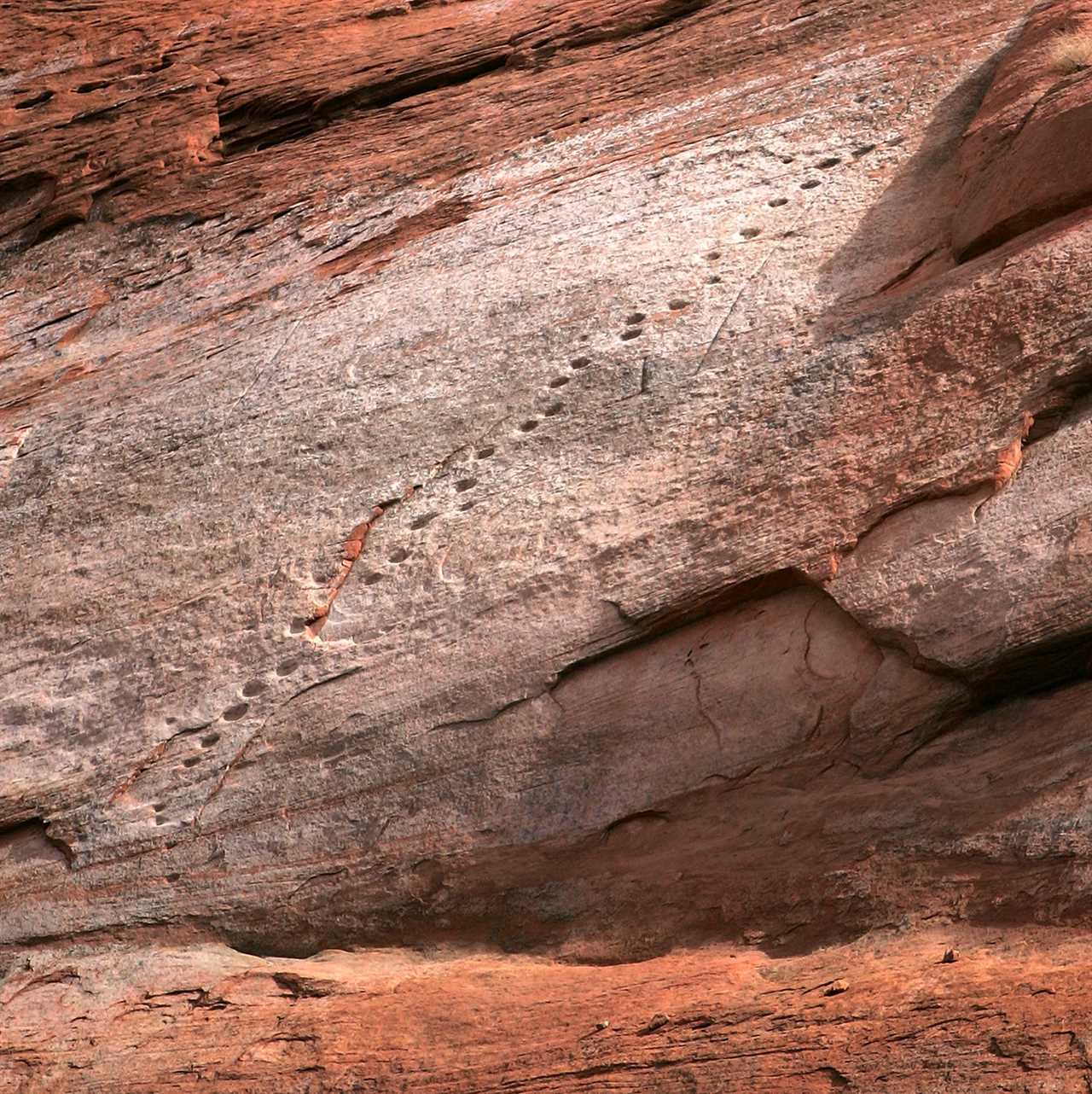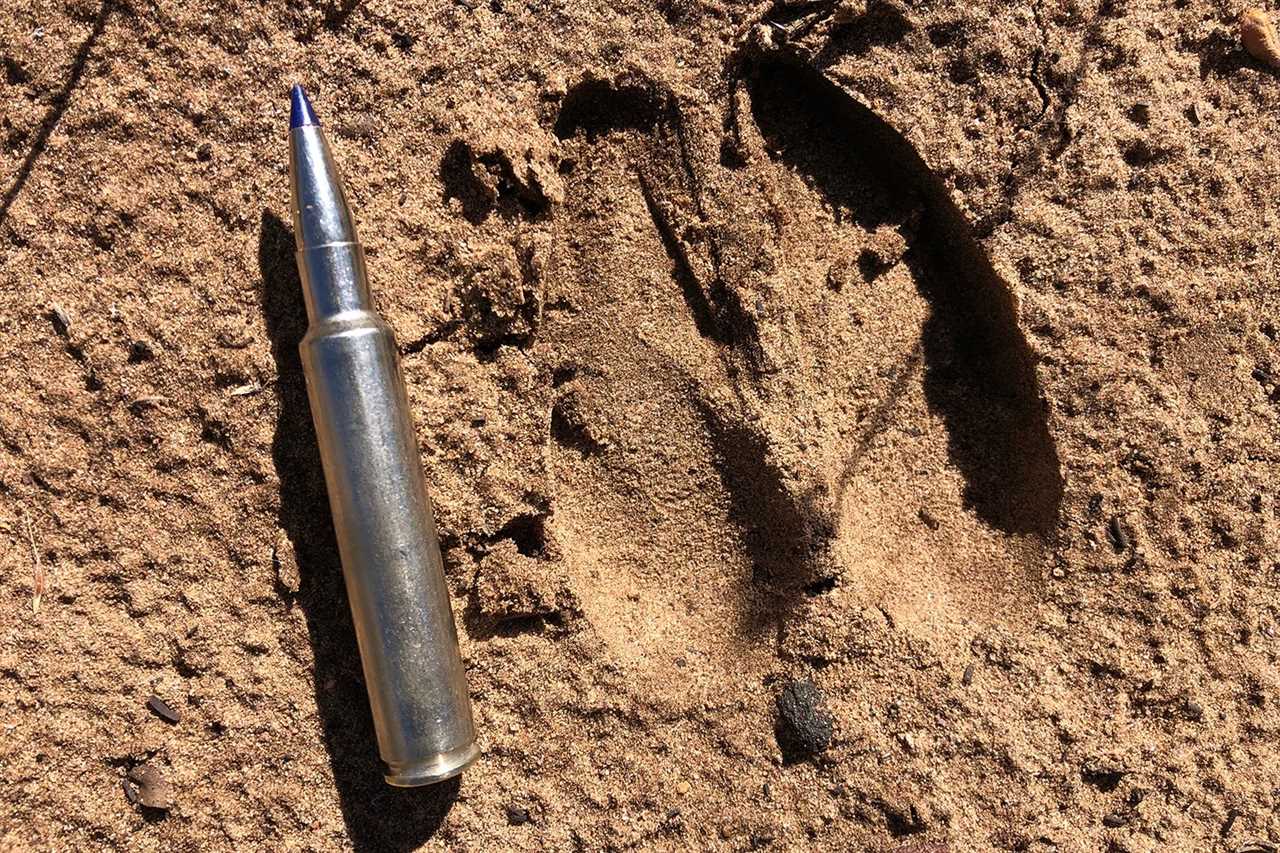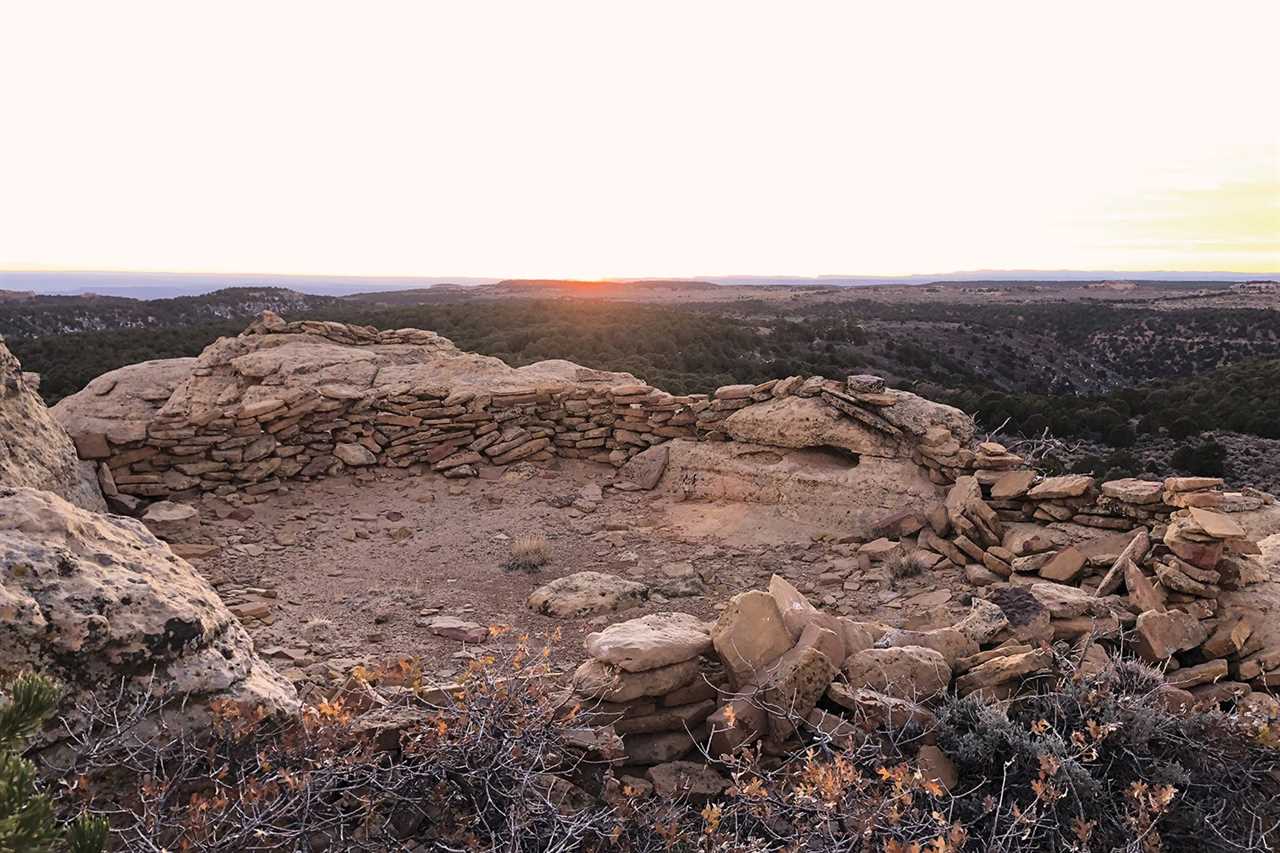The author’s son Josiah scans the horizon for mule deer. Aram von Benedikt
FROZEN SAND crunches under our boots as we walk, following the dancing beams of our headlamps into the darkness. It is cold. Frost bites at our noses and fingers, and our breath forms ghostly clouds of steam. Blacktop roads and city lights are many miles away; here lives only the pungent smell of sagebrush and the hope of a monster buck at dawn. That hope draws us on, my son and me, down the desert trail and across rocky canyons. The Big Dipper rides above my left shoulder and Orion, the hunter, over my right. I offer a silent petition for a good day’s hunt.
We’ve been bivouacked in the backcountry of southern Utah for over a week now, living from our packs and hunting elusive desert mule deer. The bucks come big here, but the desert is bigger. A couple of days ago my 14-year-old, Josiah, tracked down and killed a giant with extra mass and heavy, bladed tines by himself. I am ridiculously proud of my son; he has the eyes of an eagle, the instincts of a lion hound, and the heart of a hunter.
Read Next: Mike Hirschi Might Be the Greatest Trophy Mule Deer Tracker in America. These Are (Some of) His Secrets
Dawn is upon us. We drop our packs to the sand and pull on another layer. I feel excited, like a child on Christmas morning. This is a new area, farther and deeper than we’ve gone before. Who knows what we might find? We shoulder our packs and point our boots toward a nearby cluster of hoodoos, tall, rounded outcroppings of Navajo sandstone that stand above the desert. We want to climb on top and glass from them. As we walk, I pluck a sprig of sage and crush it, rolling it between my fingers.
The hoodoos are steep, and I wonder if we can even climb them. A small seam on the west side looks like it might offer a route, and as I near it I see a Moqui step carved into the sandstone. Then I spot another, and another, the steps spiraling upward. It seems we’re not the first with a mind to climb these hoodoos.
The Old Ones, the people who lived here even before the Navajo and Paiute, carved these steps into the sandstone. Their ladders are known as Moqui steps, although ladders is probably too generous a word; the steps are well placed but only deep enough to accommodate a few toes. I’ve heard of steps strategically placed to confuse the feet of an enemy, leaving him hanging above a precipice until he could hold on no longer. There is no precipice here, though, so I try the first step, and the next.

Ancient Moqui steps carved in the desert. David McNew / Getty Images
The top is rugged but somewhat level, and we’re enthralled to find stone walls standing fortress-like. Some have tumbled over time but many stand, imperturbable and unaffected by the thousand years since they were stacked. The place feels welcome but mildly haunted too. Why did the Old Ones carry all these stones to the tops of the hoodoos? What threatened them?
Mysteries abound that will never be answered, so Josiah and I find a sheltered place to sit and glass with our binoculars, trying hard to spot a buck feeding in the distant sage flats. When we find no deer, we descend the Moqui steps to search the sage.
In the sand is a track—a very large, heart-shaped buck track. This is the kind of footprint we’ve been hoping to find: one that likely belongs to a giant buck. We whisper, afraid that we may have given away our presence already. We follow the hoofprints backward a few steps to see where the buck came from and then, cautiously, begin to track. It becomes apparent from the tracks hard-frozen in the sand that the sign is a day old, so we abandon caution and hurry along.
I can still hunt better than most, but it hurts a lot more than it used to. Watching my son outstrip me along this track feels poignant, like a dark cloud on my horizon.
The tracks climb a small ridge and then dip down the north side. We follow, sliding down a slickrock face. It’s obvious the deer spends a lot of time here; his sign is everywhere. Tracks a day old, three days old, a week old crisscross the ground, and then we learn why: the buck is here to lick snow on the shaded north slope. He moves from patch to patch, leaving smudged divots all over the crystalized snow. Occasionally he drops to his knees to reach the moisture more easily. We find a place where he bedded, then another. The trail isn’t hot, but it’s becoming warmer.
The tracks leave the north slope to cross a ridge, and there we find it: the place where he was bedded just moments ago. Running tracks are gouged deep in the thawing sand. We rush to a ledge that offers a bit of vantage, but the pinyon and junipers are too thick for us to see through. Back on the tracks, we push on, faster now, adrenaline spiraling through our guts and giving wings to our feet.
The deer circles toward a deep canyon, now slowing to a trot. Still we hurry; perhaps he will cross the canyon and I’ll get a shot. We find where the buck fishhooked into a thicket and bedded to watch his back trail. This deer knows we are on him. He’s left us behind again, struggling to find his trail through the rocks of the canyon rim. The trail drops off the edge, zigs toward the top, then zags again. I’m growing weary, my legs heavy and tired. Slowly we work out the trail, sometimes losing it for an hour before finding a dim smudge that leads us onward. The sun drops toward the west and the day has grown warmer. As we track, Josiah finds a broken arrowhead, and always there are pottery shards, some of them painted with beautiful geometric patterns.

The track of the big-footed buck beside a .280 Ackley Improved cartridge. Aram von Benedikt
The buck has relaxed now and is feeding, circling juniper trees and picking up berries blown down by the wind. He has urinated several times, punching concentric holes into the sand, removing any doubt that this is a buck track. When he poops, he drops turds instead of the typical pile of pellets. He’s a bit dehydrated. He should eat more snow.
We follow on high alert, and a cartridge rests hot in my rifle’s chamber. My scope is turned to its lowest power—if we spot him in this thicket, the shot will be close. The pinyon and juniper are too thick, though, and I hear him jump and run, bounding through the sagebrush. We run too, trying for a glimpse before he outdistances us again, but he runs better than we do.
Still, we push hard, trying to stay with him. The sun is low on the horizon now, painting the distant sandstone cliffs and hoodoos gold. Josiah follows the tracks while I look for the buck, following my son at a running walk through the chest-deep sage. I’m in good condition and hardened from living in the desert, but the distance between us grows. His tag is filled, but the instinct to hunt burns hot and his desire to help me get a buck is strong. He is focused, determined, intent. I push myself hard and manage to close the gap a bit. If we see the buck, I need to be in position for a shot.
The buck has circled his home territory now without losing us and seems to change his strategy, heading back toward the hoodoos with the Moqui steps and rock fortress. No longer does he stop and bed, trying to escape our attention. Now he’s just leaving the country. My son is in a trot, and I follow, my pack heavy and my legs heavier. Breathing in ragged, half-controlled gasps, I watch the sage flats and juniper ridges ahead, hoping to see the big-footed buck. If he’s as old as his track and his savvy indicate, he could be one of those giant desert bucks that haunt my dreams.
I push hard, but still Josiah forges ahead. When I was young, other hunters accused me of being a mountain goat. Now I travel more deliberately, the years and the miles and the injuries taking their toll. I can still hunt better than most, but it hurts a lot more than it used to, and watching my son outstrip me along this track feels poignant, like a dark cloud on my horizon. The time is coming when he will hunt and I will watch him go, much like he watched when he was little, seeing me leave for the mountains with eyes large and sad.

The ancient fortress from where the author finally gets a look at the buck he’s been tracking. Aram von Benedikt
But I can’t worry about that now. So I just enjoy watching him and focus on my breath and where I put my feet. I have a job to do, and if Josiah jumps that buck, by dang I’m going to be there to shoot it.
We near the Moqui hoodoos again, and Josiah turns to me with a suggestion.
“Why don’t you run and get up on those hoodoos?” he whisper-shouts. “Maybe you can spot the buck while I track him.”
I welcome the suggestion because I’m about done. I nod and Josiah is off, bounding along the smoldering tracks. I sprint too, using the last of my reserves to reach the hoodoos and go up the Moqui steps in a run. Moqui steps should never be climbed in a run. But I make it and trot across the tops, mumbling an apology as I run across the top of a thousand-year-old wall and skid to a halt on a hoodoo. I’ve already snapped my bipod to my rifle, and I flop down on the sandstone beside it, binoculars scanning the distant sage and juniper flats. I see nothing but flashes of my son’s orange vest as he tracks toward the distant golden cliffs. Had I been here five minutes ago, I’d have had an easy 200-yard shot at the passing buck.
My lungs still heave as I scan the sage, urgently trying to find the buck. Two does stand out startlingly clear in the light of the setting sun, and then I see something running, walking, and then running again. Finally, there is the buck. He’s out of range, but there’s no doubt it’s him: He’s so tired he can’t hold a trot for more than a few steps at a time, his jaw gaping, reaching for breath just like me. He’s a little 3×3 with a rack the size of an average 2-year-old buck. I can’t tell whether he’s a youngster with the instincts of a born Houdini or an old, smart buck with declining antlers.
A grin spreads across my face, and then I laugh, startling the Old Ones watching me. Still heaving for breath and giggling, I collapse in a heap. Ol’ Bigfoot is just a little bitty buck. We’ve tracked him for all of 8 miles and a day, and that deer still gave us the slip.
I signal Josiah and, laughing, we find our way back together.
Read more OL+ stories.
The post Tracking Desert Mule Deer with My Son Is a Vision of the Past, Present, and Future appeared first on Outdoor Life.
Articles may contain affiliate links which enable us to share in the revenue of any purchases made.
By: Aram von Benedikt
Title: Tracking Desert Mule Deer with My Son Is a Vision of the Past, Present, and Future
Sourced From: www.outdoorlife.com/hunting/tracking-desert-mule-deer/
Published Date: Wed, 08 Feb 2023 18:00:00 +0000
----------------------------------------------
Did you miss our previous article...
https://manstuffnews.com/weekend-warriors/the-latest-solar-power-deals
 Backyard GrillingWeekend WarriorsAdvice from DadBeard GroomingTV Shows for Guys4x4 Off-Road CarsMens FashionSports NewsAncient Archeology World NewsPrivacy PolicyTerms And Conditions
Backyard GrillingWeekend WarriorsAdvice from DadBeard GroomingTV Shows for Guys4x4 Off-Road CarsMens FashionSports NewsAncient Archeology World NewsPrivacy PolicyTerms And Conditions
